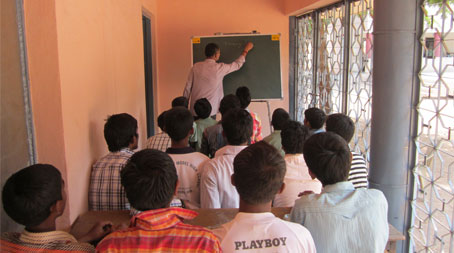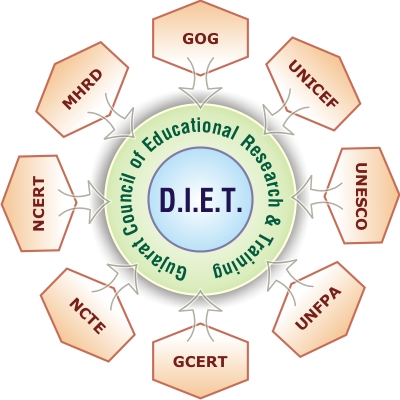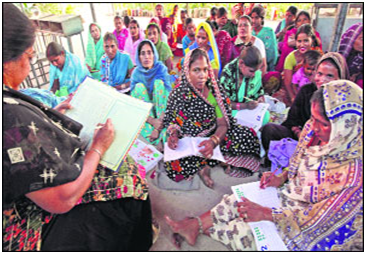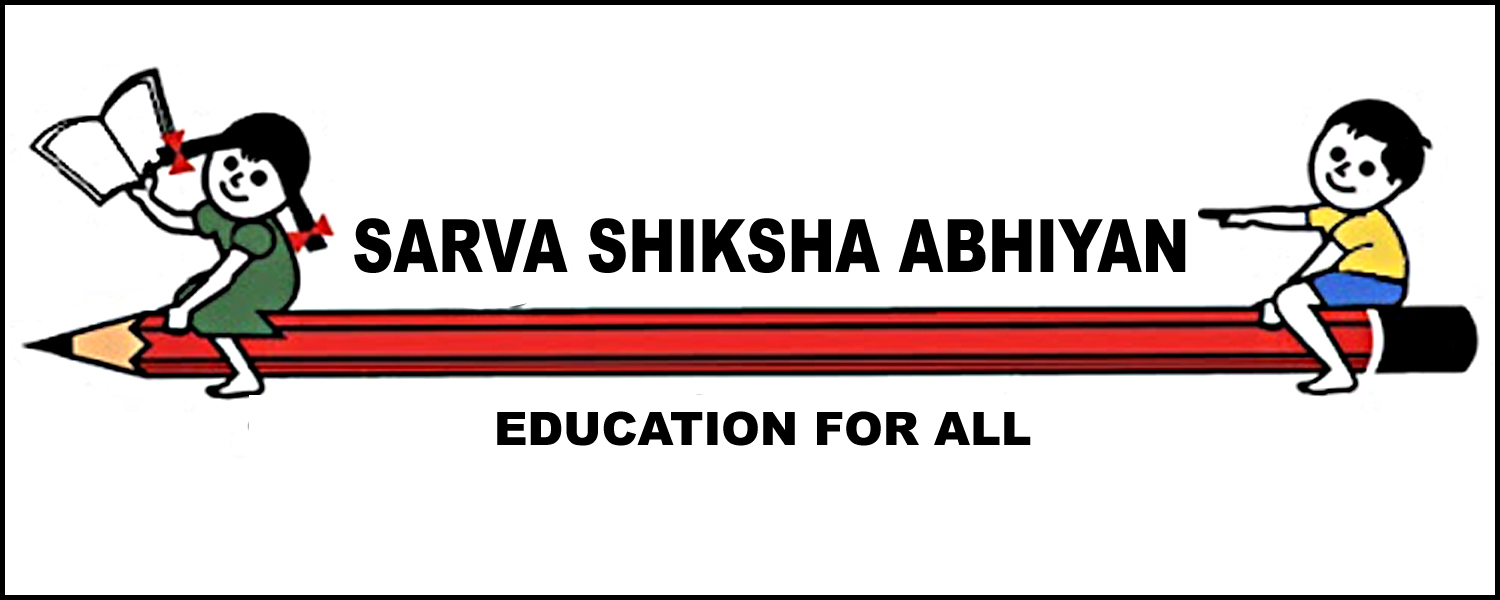Since independence, India has made considerably progress towards the goal of UEE. However, past trends do not indicate that the goal is right now in the sight. However, the trend can be reversed and goal may be achieved earlier than projected, if concerted efforts are made to bring all concerned under the umbrella of education. The Union Government initiated a number of projects and programmes under the Centrally Sponsored Schemes most of which have been initiated after the National Policy of Education was evolved in 1986 and World Conference on Education for All held at Jomtien in 1990. Some of these projects in terms of their objectives and major achievements are briefly discussed below.
(a) The Scheme of Operation Blackboard
The scheme of Operation Blackboard (OB) was launched in 1987 to improve facilities in schools by providing for more teachers, rooms and teaching learning equipments. The OB Scheme seeks to bring both the quantitative and qualitative improvements in primary education. The scheme had three components, namely (i) an additional teacher to single teacher primary schools; (ii) providing at least two classrooms in each primary school; and (iii) providing teaching-learning equipment to all primary schools. The scheme is implemented through the
State Governments with 100 per cent assistance from the Central Government towards the salary of additional teachers and teaching learning equipments. It was proposed to cover all primary schools under the OB scheme that were in existence as on September 30, 1986.
Construction of school buildings is the responsibility of the State Governments but funds were arranged for this purpose from other Ministries like the Rural Development. However in the revised scheme, assistance is made available to State Governments on 75:25 share basis. For construction of school buildings, an amount of Rs. 2,308 crores (about 550 Million US $) has been invested on OB scheme. About 185 thousand classrooms are constructed, 1.49 thousand teachers appointed and 520 thousand schools were provided teaching-learning equipments. Recently the OB scheme has been extended to upper primary level and sanction of third teacher to primary school having enrolment more than 100 has also been provided. During the Ninth Plan, third teacher was provided to more than 22 thousand
schools and about 78 thousand upper primary schools were covered and teaching-learning material supplied.
Despite all these significant achievements, all is not well in schools. Large number of primary schools still has only one teacher and do not have adequate physical facilities and other teaching-learning material. In addition, a few schools do not have buildings and those who have, may not be in good condition and need repairs. The instructional rooms are also not adequate in a good number of primary schools. Even if the teaching-learning material is available that itself is not a guarantee that teachers are equipped to utilize these aids, which is noticed recently even in a state like Kerala also. The OB support is one time affair and the material provided under the scheme may not even traceable in a good number of schools. Even teachers in schools spread over four states that we visited recently were not aware of such equipments in schools. Teachers in other schools where the OB kits are available are of the view that they are inadequate.
It has also been noticed that teachers appointed under the OB scheme are not efficiently deployed in schools. That is why we still have single-teacher schools. On the other hand, a few schools have got more than adequate number of teachers. This is more so true in case of schools located in urban areas or in rural areas located near to towns and cities. The OB scheme envisaged that one of the two teachers appointed under the scheme would preferably be a female teacher. No doubt, OB interventions have improved number of female teachers but in many locations their share is still poor. On an average we have one female teacher for every 2 & 3 male teachers respectively at primary and upper primary level. Detailed evaluation of the scheme is presently carried out by NIEPA and the report is expected soon.
(b) District Institutes of Education and Training

The scheme to strengthen teacher education by establishing quality training institutions, such as, the District Institutes of Education and Training (DIET) was initiated in 1987. The scheme proposed to create viable institutional, academic and technical resource base for orientations, training and continuous up-gradation of knowledge, competence and pedagogical skills of school teachers’ in the country. The guidelines provided seven academic units with 22 faculty positions that cover different areas such as planning and management, education technology, material development etc. Since then 433 DIETs have been sanctioned of which 401 are functional. Below the district level, under DPEP, Block Resource and Circle Resource Centres have been established that ensure capacity building at the grassroots level. In non-DPEP districts, such institutions are not in existence. However, the Sarva Shiksha Abhiyan envisages creating BRC and CRC in non-DPEP districts. The DIETs are now twelve years old but still many of them do not function as was envisaged in its guidelines (Box 3).
(c) Non-Formal Education
The Non-Formal Education (NFE) scheme was initiated in 1979 to cater learning needs of working children and children in difficult circumstances is one of the other important centrally sponsored schemes. The NFE programme is for the children of 6-14 age group who remain outside the formal system due to various reasons. Initially, the focus of the programme was on to Nine Educationally Backward states but at present it is in operation in 25 states. In 1999, there were 297 thousand NFE centers, which had a total enrolment of 7.42 million. The duration of NFE course is two years and a locally recruited and trained instructor is provided to impart education (equivalent to formal system) at a time and place most convenient to learners in smaller groups. A large number of voluntary agencies are also involved in NFE programme. The total number of centers run by voluntary agencies was 59 thousand in 1998-99. An amount of Rs. 1,195 million to States & UTs and Rs. 400 million to voluntary agencies was released in 1998-99 for the implementation of the programme. The scheme is recently revised and named as Scheme of Alternative and Innovative Education. The scheme envisages that all habitations that do not have an elementary education centre within a radius of one kilometre will have one at the earliest. As a part of the scheme, school-mapping exercise will be conducted to identify school-less habitations, which will help to locate habitations where alternative centres are to be provided.
(d) Total Literacy Campaigns
 The Total Literacy Campaigns mobilize communities and contributed to greater participation of children in schools. So far 450 districts have been covered under the TLC of which 250 campaigns have moved into post-literacy and 65 to continuing education stage. The campaigns cover an estimated 148 million persons. Of 94 million persons enrolled, so far 73 million persons have been completed level III. The uniqueness of the TLC lies in the fact that it is delivered through voluntarism. The programme is being implemented through the Zilla (district) Saksharata Samities created for the purpose. As mentioned, literacy rate has improved from 52 in 1991 to 62 percent in 1998.
The Total Literacy Campaigns mobilize communities and contributed to greater participation of children in schools. So far 450 districts have been covered under the TLC of which 250 campaigns have moved into post-literacy and 65 to continuing education stage. The campaigns cover an estimated 148 million persons. Of 94 million persons enrolled, so far 73 million persons have been completed level III. The uniqueness of the TLC lies in the fact that it is delivered through voluntarism. The programme is being implemented through the Zilla (district) Saksharata Samities created for the purpose. As mentioned, literacy rate has improved from 52 in 1991 to 62 percent in 1998.
(e) National Programme for Nutritional Support (Mid-day Meal)
The National Programme for Nutritional Support to Primary Education (launched in 1995) provides food grains/cooked meals to children in primary classes. The programme assures 100 grams of grains per day for attending schools for at least 80 per cent of the total school days in a month. The programme had benefited more than 98 million children spread over 0.69 million schools. In the latest year, about 9.90 million children are covered under the scheme and allocated 2.71 million metric tones of grains (Annual Report: MHRD, 1999-2000). Along with teachers, local community is also given responsibility in the distribution of grains. In previous years, a significant gap has been noticed in quantity of food grains sanctioned and actually lifted. However, only 65 and 42 per cent children of age group 6-11 and 11-14 years were found to be attended primary and upper primary schools in 1995-96 (NSSO, 1998). Since then the same, due to mid-day meal intervention might have improved to a significant effect. This is also reflected in the absolute enrolment during the period 1995-98. A few states are not keen to implement the scheme because of the administrative problems or states like Punjab even do not need such type of programme. Punjab is the highest food grains produced state of the country. In difficult areas, the administrative cost is much higher than the actual cost of the food grains. The evaluation of the programme shows that on one hand it has given boost to enrolment in a few states, on the other hand it has had a positive impact on attendance in other states.
Innovative Projects and Programmes
District Primary Education Programme
The state specific basic education projects in Bihar (Bihar Education Project), Rajasthan (Lok Jumbish & Shiksha Karmi), Andhra Pradesh (Andhra Pradesh Primary Education Project), Uttar Pradesh (Uttar Pradesh Basic Shiksha Project) and the District Primary Education Programme are of recent origin. Among these, the scope and coverage of DPEP is much more wider than other programmes of similar nature. The programme that was first introduced in 1994 in 42 districts spread over seven states is now under implementation in about 240 districts of fifteen states. The programme is structured in such a fashion so that it can provide additional inputs over and above the provisions made by the state governments for elementary education. Eighty five per cent of the project cost is shared by the Government of India and the rest 15 per cent by the concerned project states. The Government of India share is resourced by external funding from IDA, European Community, Government of Netherlands, DFID (UK) and UNICEF.
OBJECTIVE OF DPEP:
The DPEP is a centrally sponsored scheme providing special thrust to achieve UEE. It takes a holistic view of primary education development and seeks to operationalise the strategy of UPE through district specific planning with emphasis on decentralized management, participatory processes, empowerment and capacity building at all levels. DPEP aims at providing access to primary education for all children, reducing primary dropout rate to less than 10 per cent, increasing learning achievement of primary school students by at least 25 per cent, and reducing the gap among gender and social groups to less than five per cent. MHRD: Annual Report, 1999-2000
Lok Jumbish and Shiksha Karmi Projects
Apart from DPEP, Lok Jumbish (Peoples’ Movement) and Shiksha Karmi Projects are the other two important programmes, which are, received attention at the international level. Both these projects are under implementation in Rajasthan since 1992, which is one of the most educationally backward states of India. Lok Jumbish and Shiksha Karmi are funded by SIDA. The main objective of LJP is to achieve EFA through people’s mobilization and participation. Whereas, SKP focuses it attention on universalisation and qualitative improvement of primary education in remote, arid area and socio-economically backward villages with primary attention given to girls. The project identifies teacher absenteeism as a major obstacle in achieving the goal of UEE. The LJ Parishad, an autonomous society, implements the LJP. Two phases of LJP during 1992 & 1994 and 1994 & 1998 are already over and the third phase (1999-2004) with the assistance of Department of International Development (UK) is currently under implementation. For the first two phases, about Rs. 1,110 million were invested and for the third phase, an amount to the tune of Rs. 2,250 million is allocated. It has undertaken environment-building activities in 8,675 villages and has completed school mapping exercise in 6,974 villages. 529 new schools have been opened and another 268 were upgraded. LJP has been able to set-up innovative management structures incorporating the principles of decentralization and delegation of authority as well as building partnership with local communities and the voluntary sector. It has also set-up vibrant block and cluster resource groups for providing academic supervision and regular training of primary school teachers.
However, it may be noted that the LJP has covered only 75 blocks, which is just one quarter of the total blocks in Rajasthan. The management cost of LJP is high compared to other programmes of similar nature. It is also not known whether the success it has achieved, will it able to replicate elsewhere in Rajasthan and outside Rajasthan. The school mapping exercises, which are conducted under the LJP, though termed as school mapping but in fact, is a micro planning exercise. The disappointing aspect is closing down of LJP in about 10 blocks and another 9 may also meet the same fate. This is because of the DPEP, which is presently under implementation in 10 districts of Rajasthan, and another 9 are in pipeline. The Government of Rajasthan decided to close down LJP in blocks, which falls under DPEP districts.
Sarva Shiksha Abhiyan
In addition to the Centrally Sponsored Schemes, states have initiated schemes to give momentum to their efforts towards the goal of Education for All. More recently, the Government of India has also initiated an ambitious programme called Sarva Shiksha Abhiyan (SSA): An Initiative for Universal Elementary Educationto achieve the goal of UEE. The programme is initially planned to initiate in about 50 low female districts spread over fifteen states. It is envisaged that all the districts of the country will come under the programme before the end of the Ninth Plan (MHRD, 2000b). Unlike the District Primary Education Programme, the SSA envisages to develop district-specific elementary education plans within the framework of decentralized management of education with a focus on Panchayati Raj Institutions. In the DPEP, the focus was only on the primary level. In these districts, it would be the first attempt to develop plans with the active involvement of local people in a participatory planning mode. District planning teams in these districts have already been formed and training in planning methodology is being imparted. Three of such programmes have already been organized by NIEPA at Shillong, Aizawl and Mussoorie where a large number of members of the district planning teams and states representatives were trained. This exercise will help to build-up capacity at the grassroots level, which will help district and sub-district officers in developing plans. It is expected that districts will initiate pre-project activities soon for which an amount of Rs. 5 million (upper ceiling) is allocated to each of the districts covered under SSA.

